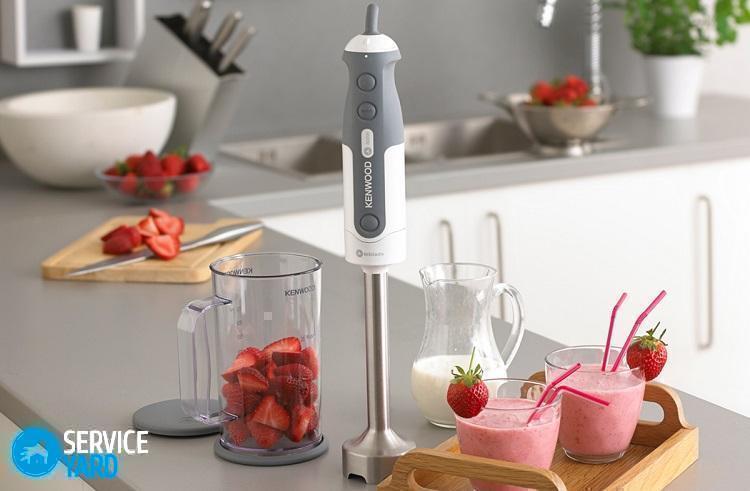How to disassemble a blender?

The blender is today the most demanded kitchen equipment. With it, housewives make their life and daily “witchcraft” much easier. There are a huge number of reasons for the breakdown of the blender, but in order to repair it, you need to properly promote it first? How to disassemble a blender and then fix it at home is the main topic of this article.
to contents ↑What is a blender?
First you need to understand what this device is all about. If you simplify the description of its entire structure, the device is an engine with a nozzle. It can have a speed controller, as well as other functionality. That is why it is not difficult to disassemble a blender with your own hands.
to contents ↑How to disassemble your Philips blender?
To do this, you will need the following tools:
- pliers;
- a thin knife or a thin flat screwdriver;
- flat and long screwdriver;
- hammer;
- glue, which is intended for aircraft models or superglue.
To disassemble the blender, follow this procedure:
- Using pliers, pull out the nozzle holder, it is also a cartridge.
- Take a narrow knife or a screwdriver, insert it between the casing and the body and beat the weld with a very light hammer blow. Repeat this action along the entire perimeter until the engine together with the casing will not move freely inside the housing itself.
Important! Be extremely careful near the locks, in no case do not repel them. It is not recommended to use a wide knife or a thick screwdriver, because a thin external case may burst.
- Drown the clips, then remove the engine.
- The engine can be reached with the control board. If this does not happen, pull the pliers on one edge of the board - it is quite easy to remove.
Important! Be extremely careful with the board because it is very fragile.
- Inside you can see 4 latches from the back cover. Bend these latches in the direction of the arrows, as a result of which the top cover will be right in your hands.
- Use a screwdriver to pry off the speed-control cover. Bend the external clips of the cable holder from the inside.
That's all, the device is disassembled

Blender working principle
To date, there are 3 varieties of blenders, namely:
- Stationary.
- Manual it is submersible.
- As part of a whole food processor.
The blender device itself in each case provides for the mandatory presence of an electric motor in the role of the main driving force, although their principle of operation is somewhat different. For example, stationary blenders are somewhat similar to those that are part of whole combines. There are only two key prefabricated parts in them, which allow this device to work, namely:
- Bowl with a knife;
- Engine.
Repairing a Philips blender or any other usually involves replacing or repairing one of these items.

Replacing a knife in a blender
As for the blender’s knife itself, it’s unlikely that you can grind it at home. You can purchase a new one, and in this case, you can expect as many as 3 options for the development of further events:
- The knife itself can be sold in the form of a separate spare part.If so, then you should take off the old one. To do this, you can use the help of an old towel, always clean. Grab a blender knife with a rag, and then start unscrewing from the spindle. Pay attention to the fact that the thread itself is left, so you must twist in a different direction than usual.
- It also happens that the knife itself is fixed with 2-3 nuts. In this case, remove it from the blender with a wrench or pliers.
Important! The bowl must be separated from the output shaft, and the plug itself is disconnected from the network. Otherwise, the rotating blender’s knife itself will easily disfigure fingers and the problem of a non-working household appliance will seem a real trifle to you in comparison with the problem that arose.
- If the knife is sold complete with an oil seal, change both parts immediately.

What to do if the blender speed controller is broken?
Quite frequent problems in blenders are associated with a speed switch. Entirely and fully checking the performance of the speed controller is possible only in the workshop. But despite this, if you have knowledge of radio engineering, try to ring this part first. Most likely, it will immediately be clear whether this is the reason for the rather strange behavior of the blender.
To do this, the switch is removed from the device itself; in other words, it is evaporated, and then all its positions are checked.
Important! During normal operation, each contact should in turn give its own short circuit.
You can try another way. Connect the device to the network, and listen to how it behaves at different speeds. Generally, the faster the blender’s knife rotates, the greater the buzz.
Important! At the same time, remember that most models have a lock when switching on without a bowl occurs.

What to do when the blender stops?
It so happens that the device does not want to work at all. But in fact, this situation is resolved much easier than if the blender does not cut, and also does not chop.
To repair a Philips blender or other model of such household appliances:
- To get started, we strain our ears, turn on the device. If there is a buzzing, it means most likely that the fact is that the knife itself cannot scroll.
- Remove the bowl, and then gently squeeze the power lock button with a finger, pencil, or pin. Earned? - If so, the case is clearly in the cup and knife.
- It is much more interesting when the buzz is present, but the blender still does not work, even if you have released the lock. Most likely the matter is in the motor, namely, one of the windings burned down. It all depends on the price of the issue, if you have the opportunity to get a new engine at the wholesale price, replace it. But if you have a cheaper model, it will be more profitable to discard the idea of fixing your own blender.
Important! In the case when you do not observe any buzzing with the button turned on, start exploring the power supply path. Check for voltage at the outlet itself. Practice shows that a large number of problems are solved just at this stage. A blender, just like any household appliance, breaks relatively rarely. Connect a working table lamp or something else to the same outlet. If all goes well, proceed to the second procedure.

Cord check
To check the cord, you need to disassemble the blender, or rather its body. Disconnect the appliance from the network, and after that take a screwdriver - most imported models will require special heads. A cross as well as a flat screwdriver will naturally not work. Inside the blender, there must be a power block, to which the cord is soldered or screwed.
Ways to check the cord:
- Check the voltage with a voltmeter or take a known-good cord, plug it in, try to assemble. This way you can localize the breakdown.
- Particularly severe cases are encountered when the voltage cannot be measured, because all the more or less suitable contacts are closed with plastic and cannot be disassembled. In order not to shred the device, take the needle and solder the wire to it. You need two of these gizmos. Disconnect the blender from the network, pierce both cores of the wire with your upgraded needles, attach the terminals of the tester. Make sure that the wires do not overlap each other - for this, keep your hands away and connect to the network. See the result on the tester display.
Stock footage
As you can see, in order to disassemble the blender, you need to have only a small amount of time and patience. But most breakdowns can still be fixed on their own. We hope you have successfully dealt with this and now you can continue to use the device that is so convenient and practical in home use.
- How to choose a vacuum cleaner taking into account the characteristics of the house and coatings?
- What to look for when choosing a water delivery
- How to quickly create comfort at home - tips for housewives
- How to choose the perfect TV - useful tips
- What to look for when choosing blinds
- What should be running shoes?
- What useful things can you buy in a hardware store
- Iphone 11 pro max review
- Than iPhone is better than Android smartphones



